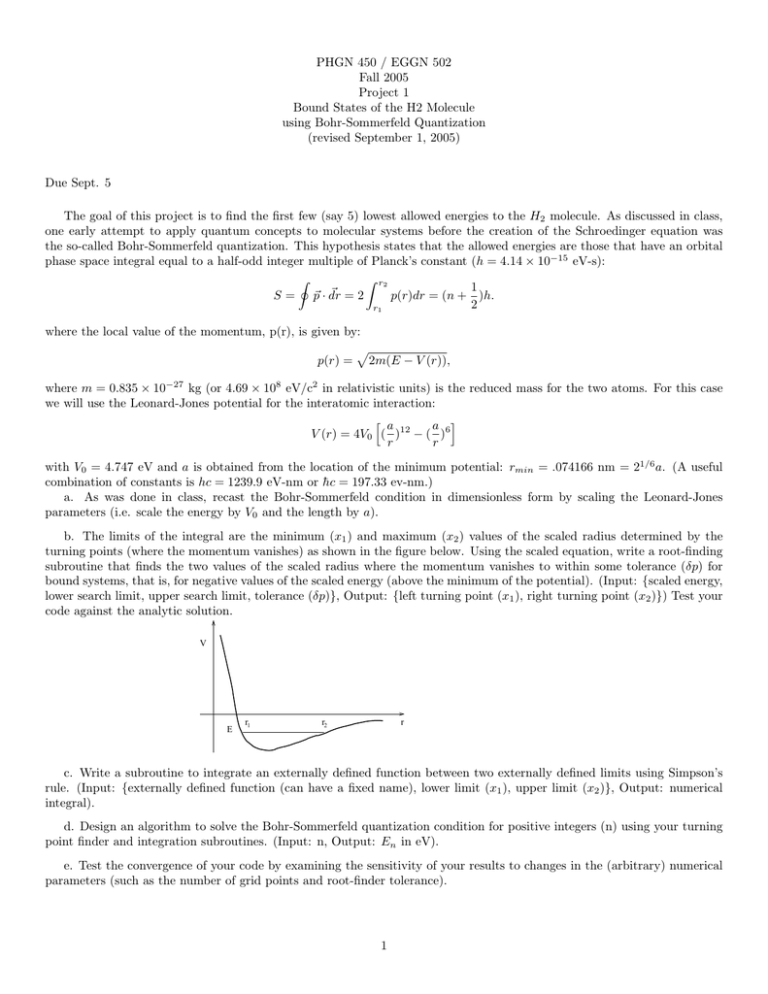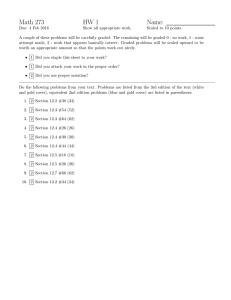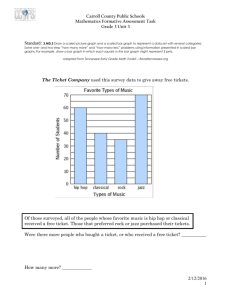PHGN 450 / EGGN 502 Fall 2005 Project 1
advertisement

PHGN 450 / EGGN 502
Fall 2005
Project 1
Bound States of the H2 Molecule
using Bohr-Sommerfeld Quantization
(revised September 1, 2005)
Due Sept. 5
The goal of this project is to find the first few (say 5) lowest allowed energies to the H2 molecule. As discussed in class,
one early attempt to apply quantum concepts to molecular systems before the creation of the Schroedinger equation was
the so-called Bohr-Sommerfeld quantization. This hypothesis states that the allowed energies are those that have an orbital
phase space integral equal to a half-odd integer multiple of Planck’s constant (h = 4.14 × 10−15 eV-s):
I
Z r2
1
~ =2
S = p~ · dr
p(r)dr = (n + )h.
2
r1
where the local value of the momentum, p(r), is given by:
p
p(r) = 2m(E − V (r)),
where m = 0.835 × 10−27 kg (or 4.69 × 108 eV/c2 in relativistic units) is the reduced mass for the two atoms. For this case
we will use the Leonard-Jones potential for the interatomic interaction:
h a
a i
V (r) = 4V0 ( )12 − ( )6
r
r
with V0 = 4.747 eV and a is obtained from the location of the minimum potential: rmin = .074166 nm = 21/6 a. (A useful
combination of constants is hc = 1239.9 eV-nm or h̄c = 197.33 ev-nm.)
a. As was done in class, recast the Bohr-Sommerfeld condition in dimensionless form by scaling the Leonard-Jones
parameters (i.e. scale the energy by V0 and the length by a).
b. The limits of the integral are the minimum (x1 ) and maximum (x2 ) values of the scaled radius determined by the
turning points (where the momentum vanishes) as shown in the figure below. Using the scaled equation, write a root-finding
subroutine that finds the two values of the scaled radius where the momentum vanishes to within some tolerance (δp) for
bound systems, that is, for negative values of the scaled energy (above the minimum of the potential). (Input: {scaled energy,
lower search limit, upper search limit, tolerance (δp)}, Output: {left turning point (x1 ), right turning point (x2 )}) Test your
code against the analytic solution.
V
E
r1
r2
r
c. Write a subroutine to integrate an externally defined function between two externally defined limits using Simpson’s
rule. (Input: {externally defined function (can have a fixed name), lower limit (x1 ), upper limit (x2 )}, Output: numerical
integral).
d. Design an algorithm to solve the Bohr-Sommerfeld quantization condition for positive integers (n) using your turning
point finder and integration subroutines. (Input: n, Output: En in eV).
e. Test the convergence of your code by examining the sensitivity of your results to changes in the (arbitrary) numerical
parameters (such as the number of grid points and root-finder tolerance).
1

